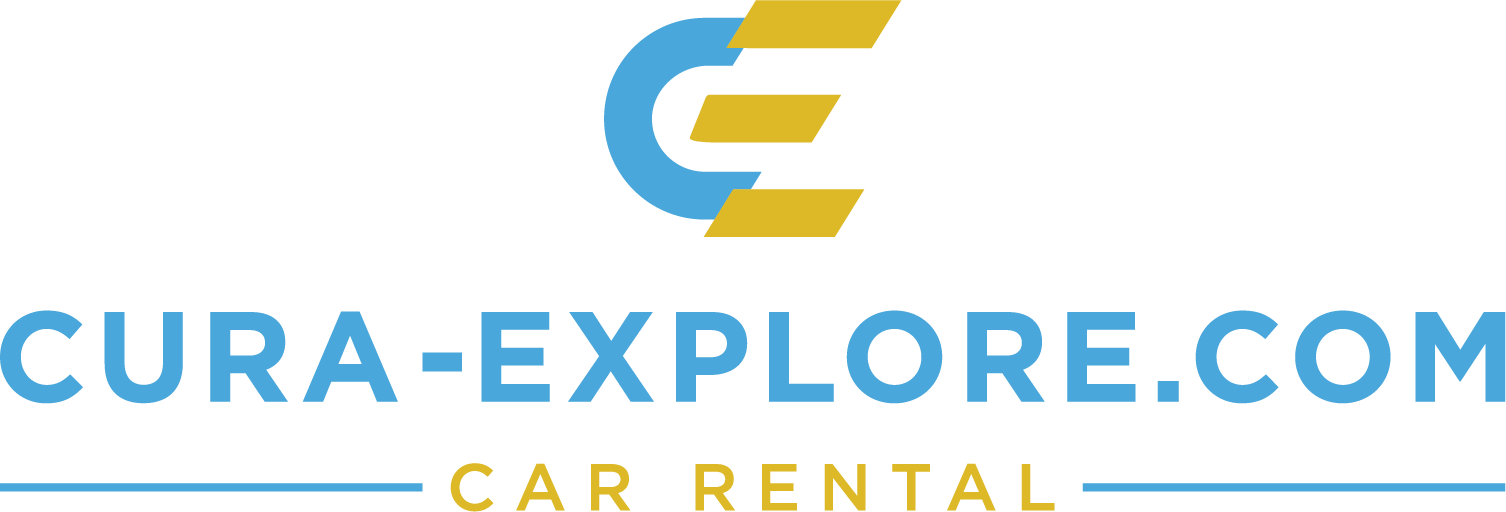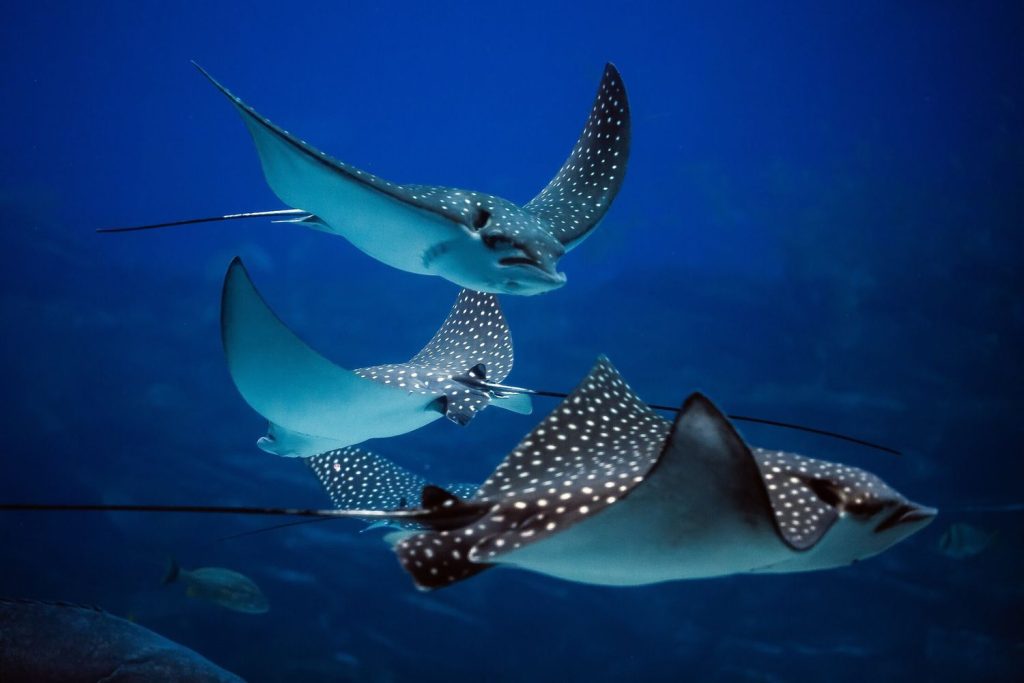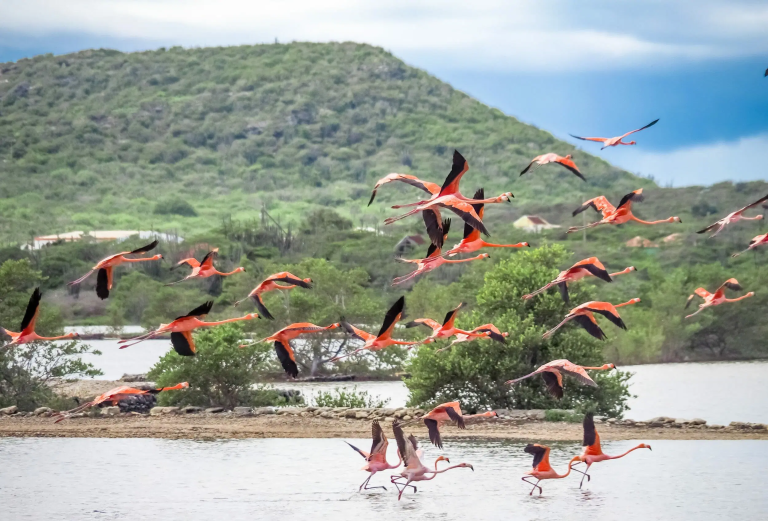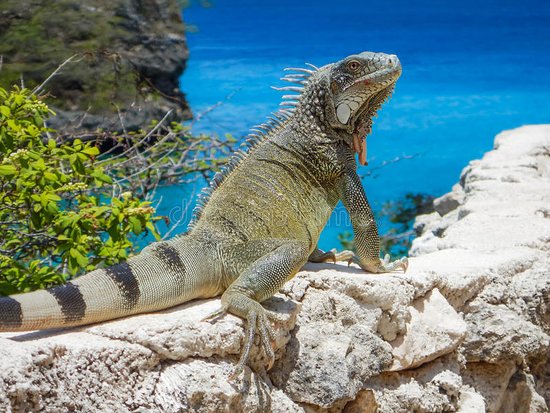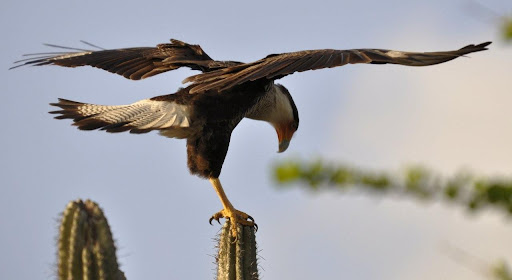Curaçao is more than sun and beaches: the island is full of life-underwater, around the salt flats, along the rugged north coast and in the hills of Banda’bou. With a rental car you plan your own route, take your snorkeling gear and water easily, and combine several hot spots in one day (public transport is limited and cabs add up fast).
1. Marine life – turtles, (spot) stingrays & coral
Best viewing time: early morning (calm water, best visibility) or late afternoon.
Top spots
- Playa Piskado / Playa Grandi (West Point) – highest chance of sea turtles at the fishermen’s jetty. Come 08:30-10:00.
- Playa Lagun – sheltered bay; often turtles, moray eels, octopus along rocky shores.
- Tugboat Beach & Directors Bay (Caracas Bay) – shallow wreck (Tugboat) with lots of reef life and various fish; fine snorkeling spot for beginners. Chance of rays and sometimes seahorses.
- Porto Mari – regularly southern stingrays over the sand flats; sometimes eagle rays along the reef.
- Playa Kalki (Alice in Wonderland) – beautiful reef; chance of moray eels, schools of reef fish.
- Blue Room (near Playa Santa Cruz) – magical cave with bright blue light (go by guide/boat/kayak).
- Klein Curaçao (day trip by boat) – crystal clear waters; often turtles, and occasionally stingrays at the drop-off. On the way you sometimes even encounter dolphins.
Doing & letting
- Do not touch/feed; keep 3-5 m distance (including rays and turtles).
- Use reef-safe sunscreen; do not touch coral.
- Bring shoes or reef-safe slippers: some beaches are pebbly.
By car: park right by the bay, bring cooler/snorkel set, and beach hop without time pressure.
2. Birds & flamingos – from warawara to hummingbirds
Best viewing time: morning (cool, lots of singing and foraging) and golden hour in the afternoon (soft light, flamingos active).
Where & what you see
- Flamingos (Phoenicopterus ruber) – Jan Kok salt flats (Saint Willibrordus) is the classic; also at Saliña Saint Michael. Keep your distance and park in designated areas.
- Warawara / Crested Caracara (Caracara plancus) – semi-predatory bird, often hovering low over open terrain or on stilts. Best chance in Banda’bou, along routes to Christoffel Park, Shete Boka and Westpunt.
- Trupial (Icterus icterus) – orange-black songbird; common around Porto Mari, Cas Abao, Christoffel Park and in gardens.
- Prikichi / Brown-throated Parakeet (Aratinga pertinax) – small parrots in groups around Jan Thiel, Spanish Water, Brakkeput and village edges in Banda’bou.
- Sugar thief / Bananaquit (Coereba flaveola) – yellow-black, likes to be near flowering shrubs and terraces (everywhere).
- Hummingbirds (Ruby-topaz, Blue-tailed Emerald) – near hibiscus/bougainvillea, in gardens/resorts and Christoffel Park.
- Brown pelican – often dives at Mambo/Sea Aquarium, Piscadera, Boca Sami and Jan Thiel.
- Frigate birds – large black gliders, often along cliffs and the south coast (including Shete Boka).
- Herons & waders – Saliña Sint Michiel, Jan Kok and Spanish Water after rain.
Handy with
- Binoculars 8-10x or telephoto lens 200-300 mm.
- Water, sun hat, and patience: staying calm pays off for closer moments.
By car: easily combine Jan Kok → Porto Mari → Cas Abao (birds + beach) or Christoffel Park → Shete Boka → Westpunt (birds of prey, frigate birds, coast).
3. North coast & Shete Boka – rugged nature and (nesting) beaches
Shete Boka National Park
Blowholes and natural inlets(Boka Tabla, Boka Pistol). In season, turtles use nearby beaches for nesting (respect deposits and signs).
Best viewing time: morning (cooler hiking) and afternoon (photo light).
By car: ± 45-60 min from Willemstad; roads are passable. Wear sturdy shoes, bring water and sun protection.
4. Reptiles & land animals
- Iguanas (yuana), black-tailed lizards, geckos – seen everywhere, especially on rocks in the heat.
- Bats (Hato Caves) – guided only; respect silence.
- Wild goats & donkeys – especially in Banda’bou; pay extra attention at dusk along the road.
- Pigs – at Porto Marie beach, the pigs often play on the beach and in the water.
By car: you stop safely at viewpoints and drive at cooler times when animals are more active.
5. Mangroves & bays – micro-safari on the water
- Spanish Water / St. George’s Bay – mangroves full of crabs, young fish and shorebirds.
- Rent a SUP/kayak on site to paddle silently through the greenery.
By car: get to starting points easily and bring dry bags/water.
Practical nature & driving tips (tourist-proof)
- Distance & respect: 3-5 m distance; do not touch/feed; drones only where permitted.
- Sun & heat: 2-3 liters of water p.p., hat, UV shirt; reef-safe sunscreen.
- Snorkel safety: watch for current/wave action (especially north coast); snorkel with buddy.
- Driving safety: goats/donkeys on country roads; drive more quietly at night. Park in official areas (not on possible nesting beaches).
- Best seasons: wildlife can be all year, but after rain (Oct-Dec) you’ll see more waterfowl around saliñas; underwater visibility is often top in the morning.
Why rent from Cura Explore?
- New, well-maintained cars with air conditioning & CarPlay/Android Auto.
- Flexible delivery & return (airport or accommodation).
- Local tips by day (which bay is quietest/clearest today).
- All-in rates and fast WhatsApp service.
In short: with a rental car, you can see turtles, (spot) stingrays, warawara, flamingos, pelicans and hummingbirdsall in one day-atyour pace, comfortably and safely. Ready to explore?
